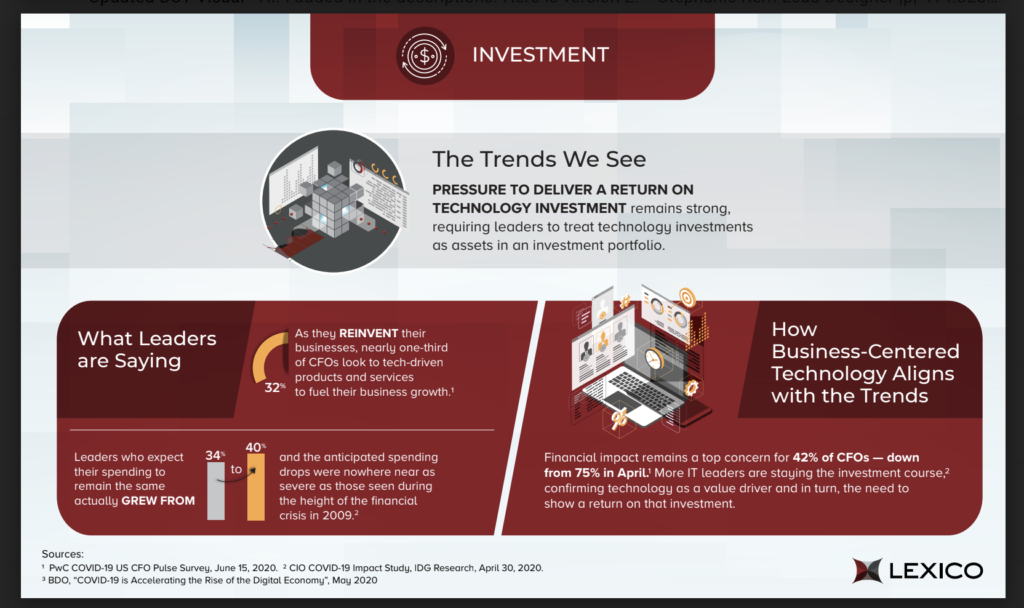Based on insights from business and technology leaders, we’ve created a new series on boosting digital transformation ROI through a business-centered technology approach. We’ve identified four key trends on this topic and are taking a deeper dive into each one, so you have a pulse on the ever-changing nature of digital transformation.
Importance of Digital Investments is Increasing
Despite the detrimental economic effects of the pandemic, technology investment is holding steady and even increasing, according to recent studies of C-suite leaders on digital transformation.
While the pandemic has propelled companies to invest in digital transformation efforts, there’s also an increased pressure to realize the value of that investment, and our consulting services can help implement this transition. According to Lexico CEO Damani Short, “If a company is going to spend 2-4 percent of its revenue on technology, the only way you can realize the value of technology investment is to connect and align it to the business.”
Another reason that funding digital transformation has become a priority is due to the fact that financial impact remains a top concern for 42% of CFOs – down to 75% in April. More IT leaders are taking the investment course. Confirming technology as a value driver and in turn, the need to show a return on that investment.
Digital Transformation Investment Trends We See
Pressure to deliver a return on technology investments remains strong, regarding leaders to treat technology investments as assets in an investment portfolio.
Using New Technology Investments for Growth
As they reinvent their business, nearly one-third of CFO’d look to tech driven products and services to fuel their business growth.
Cloud Computing and Storage Solutions
Adopting new technologies can help save money in the long run. Digital investments like Cloud computing can reduce the cost of IT infrastructure and maintenance, as well as provide pay-as-you-go pricing models.
Cybersecurity and Data Protection
Digital transformation can enable the use of advanced technologies such as artificial intelligence and machine learning to detect and respond to cyber threats in real-time, minimizing the risk of data breaches and other security incidents.
Automation and Process Optimization
Digital transformation investments can enable organizations to implement digital customer engagement tools and technologies such as chatbots and self-service portals, which can improve the customer experience and reduce the workload of customer service teams.
How Business-Centered Technology Aligns with Digital Transformation Investment Trends:
Business-centered technology aligns with digital transformation investment trends in several ways:
- It focuses on delivering business value: Business-centered technology is designed to align with an organization’s strategic goals and objectives, with a focus on delivering measurable business value. It is not just about implementing the latest technology for technology’s sake, but rather about using technology to drive real business outcomes.
- It prioritizes customer experience: Business-centered technology puts the customer at the center of everything, by using technology to improve the customer experience, increase engagement, and foster loyalty.
- It supports process optimization: Business-centered technology can be used to optimize and automate business processes, increasing efficiency, reducing costs and improving decision making.
- It enables data-driven decision making: Business-centered technology can be used to collect, analyze and make sense of data, which can be used to drive business decisions and improve performance.
- It supports digital innovation: Business-centered technology can be used to support digital innovation, by providing the necessary infrastructure and tools to develop, test, and deploy new digital products and services.
- It enables remote work and collaboration: Business-centered technology can be used to enable remote work and collaboration, by providing employees with the necessary tools and platforms to work effectively from anywhere, at any time.
Digital transformation can deliver, at minimum, cost savings and efficiency. But we’ve seen ambitious companies take a business-centered technology approach to their digital transformation investment, boosting growth and innovation as a result. These companies are not pulling back on their investments at all. When the business and technology objectives are aligned, the realization of business value and return on technology investment can happen.

